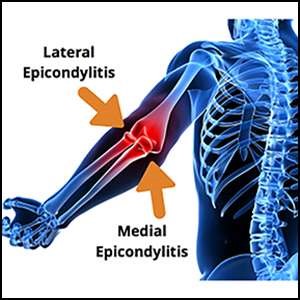Low Dose Radiotherapy for Golfer’s Elbow and Tennis Elbow
Tendonitis in the elbow, known medically as epicondylitis humeri and more colloquially as golfer’s elbow or tennis elbow, is a painful and frustrating inflammatory condition. You don’t have to be an athlete to suffer from it, as it’s caused by repetitive motions that strain the tendons in your elbow. Simple everyday tasks like drinking a cup of coffee or turning a doorknob can become painful challenges over time. If you’ve tried treating your tendonitis with rest, ice, physical therapy, and anti-inflammatory medications and still haven’t found relief, low-dose radiotherapy for golfer’s elbow could be the answer.

How it Works
Most people associate radiotherapy and radiation treatments with cancer. However, lower doses of radiation have been used for over 100 years to treat chronic inflammatory conditions. Small amounts of radiation have been shown to reduce inflammation and promote healing for conditions like epicondylitis humeri, or golfer’s elbow.
First, low-dose radiotherapy for golfer’s elbow reduces inflammation by lowering the body’s production of the naturally occurring chemicals that cause inflammation and stopping inflammatory cells from rushing to the area in pain, in this case, the elbow. Reducing inflammation reduces overall pain. Low-dose radiotherapy also reduces pain receptor sensitivity, further contributing to patients feeling less pain overall.
Second, radiotherapy promotes healing. Inflammation is part of the body’s healing process, but too much inflammation can be detrimental to healing. Reducing inflammation helps healthy cells to carry out their functions better in the body and helps it to heal.
What to Expect with LDR
Before beginning low-dose radiotherapy for tennis elbow or golfer’s elbow, you’ll meet with our radiation oncologist, Dr. Juno Choe. Dr. Choe has over 15 years of experience in radiation technology and keeps the Northwest Cancer Clinic at the forefront of technological advancements so we can improve patients’ lives. After consulting with you about your tendonitis, Dr. Choe will determine whether low-dose radiotherapy is right for you.
Patients who move forward with radiotherapy typically come to the clinic twice a week for three weeks, for six total treatments. Treatments take just a few minutes, while patients sit or lie down comfortably. Much of the time spent receiving low-dose therapy for golfer’s elbow is having the machine adjusted in just the right way. Patients can immediately resume normal activity after treatment and go about their day.
Low-dose radiotherapy for tennis elbow has little to no side effects. Some patients may experience skin redness or dryness at the area of treatment, but these side effects are usually temporary. In some ways, this non-invasive treatment can actually be safer than taking anti-inflammatory medications, which can come with different side effects that may be longer lasting.
Why Choose Radiotherapy for Golfer’s Elbow and Tennis Elbow
Especially for patients who have been suffering from epicondylitis humeri for a long time, low-dose radiotherapy for tennis elbow could bring the relief you’ve been seeking. In many cases, radiotherapy has been shown to be more effective than other types of tendonitis treatment for relieving pain, and the relief from pain lasts much longer.
If you’ve been dealing with chronic elbow pain for a while, low-dose radiotherapy for golfer’s elbow or tennis elbow could be the solution you need. Don’t let daily pain keep you from doing what you love, whether it’s playing a sport or doing work you enjoy. Try safe, effective, and non-invasive low-dose radiotherapy.

